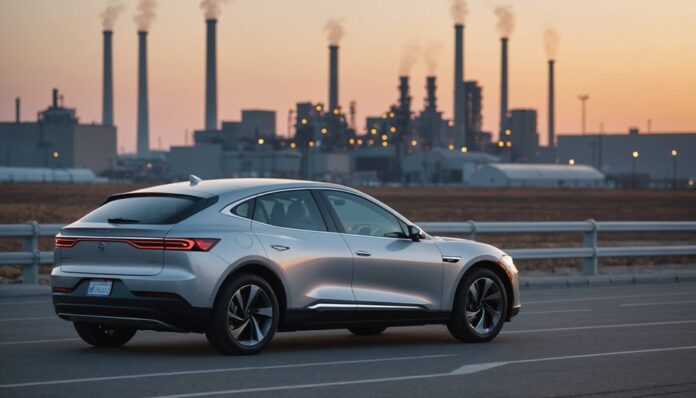The 2025 updates in emission standards mark a significant shift towards reducing greenhouse gas emissions and promoting sustainability. Stricter regulations for internal combustion engines and enhanced incentives for electric vehicle adoption aim to improve air quality and combat climate change. As governments and industries begin to implement these changes, the implications for the environment, economy, and society as a whole remain to be seen, sparking questions about the impact of these updates on a global scale.
Highlights
- The 2025 emission standards updates focus on reducing greenhouse gas emissions and promoting sustainability through electric vehicle advancements and renewable energy integration.
- Stricter emissions standards for vehicles aim to encourage electric vehicle adoption and reduce reliance on fossil fuels.
- Renewable energy sources like solar and wind power are being promoted to reduce dependence on fossil fuels in energy production.
- Manufacturers and industries must adapt production processes to meet new standards, potentially investing in cleaner technologies and efficient practices.
- Compliance with the updated standards poses challenges, including substantial costs and technological hurdles, particularly for small and medium-sized businesses.
Overview of 2025 Emission Standards Updates
As the environment continues to be a pressing concern globally, the 2025 emission standards updates are being implemented to further reduce greenhouse gas emissions and promote sustainability.
The updates focus on two primary areas: electric vehicle advancements and renewable energy integration. Stricter emissions standards for vehicles will encourage the adoption of electric vehicles, leading to a decrease in greenhouse gas emissions from transportation.
Additionally, the integration of renewable energy sources, such as solar and wind power, into the grid will reduce reliance on fossil fuels and lower emissions from energy production.
These updates aim to mitigate climate change, improve air quality, and promote sustainable development, ultimately contributing to a healthier environment and a more sustainable future.
Key Changes in Transportation Emission Standards
Implementing significant revisions to existing regulations, the 2025 emission standards updates introduce stringent emissions requirements for vehicles, marking an essential step towards reducing greenhouse gas emissions from transportation.
The updated standards prioritize electric vehicle incentives, aiming to increase adoption and reduce emissions from the transportation sector. Public transport improvements, such as upgraded bus fleets and expanded transit systems, are also emphasized to reduce reliance on personal vehicles.
Stricter emissions standards for internal combustion engines will be enforced, encouraging manufacturers to develop cleaner, more efficient technologies.
Updates to Energy Sector Emission Standards
Building on the momentum of reducing greenhouse gas emissions from transportation, the 2025 emission standards updates also introduce critical changes to the energy sector.
A key focus of these updates is the promotion of renewable energy sources, such as solar and wind power, to reduce dependence on fossil fuels. Additionally, the new standards emphasize the importance of carbon capture technologies to minimize emissions from existing energy infrastructure.
These updates aim to drive growth in the renewable energy market and encourage the development of more efficient carbon capture methods. By prioritizing these technologies, the energy sector can notably reduce its carbon footprint and contribute to a more sustainable future.
The updated standards provide a structure for the energy sector to shift towards cleaner, more environmentally friendly practices.
Implications for Manufacturing and Industry
While the 2025 emission standards updates primarily target the energy and transportation sectors, they also carry significant implications for manufacturing and industry.
Companies will need to adapt their production processes to meet the new standards, which may involve investing in cleaner technologies and implementing more efficient practices. This could have a ripple effect throughout the supply chain, as manufacturers work with suppliers to reduce emissions and meet the updated standards.
Industries that are heavily reliant on fossil fuels, such as cement and steel production, will be particularly impacted. Meeting the new standards will require significant changes to their operations, which could lead to increased costs and potentially alter the competitive environment.
Manufacturers will need to balance compliance with maintaining profitability.
Increased Adoption of Clean Technologies
A key consequence of the 2025 emission standards updates will be the accelerated adoption of clean technologies across various sectors.
As industries work to meet the new standards, investment in clean technology adoption is expected to increase considerably. Renewable energy integration will play an essential role in this change, with solar and wind energy emerging as preferred sources of power.
The adoption of electric vehicles and energy-efficient solutions will also gain momentum, driven by government incentives and declining technology costs.
As clean technologies become more prevalent, economies of scale will improve, making them more competitive with fossil fuels.
This shift will not only reduce greenhouse gas emissions but also create new economic opportunities and jobs, driving growth and development in a more sustainable direction.
Impact on Government Policies and Regulations
As the 2025 emission standards updates take effect, governments will need to reassess and revise their policies and regulations to guarantee a smooth changeover to a low-carbon economy.
This will involve significant policy shifts, including the development of new regulatory structures that support the adoption of clean technologies and reduce greenhouse gas emissions.
Governments will need to balance the need to reduce emissions with the need to guarantee economic growth and stability.
Effective regulatory structures will be essential in driving the changeover to a low-carbon economy, and governments will need to work closely with industry stakeholders to guarantee a coordinated approach.
Benefits for Environmental Sustainability
Implementing the 2025 emission standards updates will have far-reaching consequences for environmental sustainability. One significant benefit is a reduction in carbon footprint, as vehicles and industries shift to cleaner energy sources and more efficient technologies.
This decrease in greenhouse gas emissions will help mitigate climate change and its associated impacts on ecosystems and human health. Additionally, the updates will promote the development and utilization of renewable resources, such as wind and solar power.
Challenges and Limitations of the 2025 Updates
While the 2025 emission standards updates offer numerous benefits for environmental sustainability, several obstacles and limitations must be acknowledged and addressed to guarantee a successful shift.
One major concern is the substantial compliance costs that industries and governments will need to absorb to meet the new standards. Small and medium-sized businesses, in particular, may struggle to remain competitive due to the financial burden of implementing emission-reducing technologies.
Additionally, technological challenges also pose significant obstacles, as the development and deployment of low-carbon technologies can be slow and require significant investment.
Overcoming these obstacles will require collaborative efforts from governments, industries, and civil society to ensure that the 2025 emission standards updates are both effective and feasible in practice.
Preparing for a Low-Carbon Future
The obstacles and limitations associated with the 2025 emission standards updates highlight the need for proactive planning and preparation to achieve a low-carbon future.
To address these challenges, experts emphasize the importance of investing in carbon capture technologies and renewable energy sources. Carbon capture can greatly reduce emissions from industrial sources, while renewable energy can provide a cleaner alternative to fossil fuels.
Governments and industries must work together to develop and implement policies that encourage the adoption of these technologies. Additionally, individuals can contribute to a low-carbon future by making conscious choices about energy consumption and supporting companies that prioritize sustainability.
Conclusion
The 2025 updates in emission standards mark a significant step towards reducing greenhouse gas emissions and promoting sustainable practices. Stricter regulations and enhanced incentives aim to improve air quality and combat climate change. While challenges in implementation are anticipated, the collaborative effort is expected to encourage cleaner technologies and sustainable practices. As governments, industries, and individuals adapt to these changes, the updates are ready to contribute to a low-carbon future and a more environmentally sustainable world.


